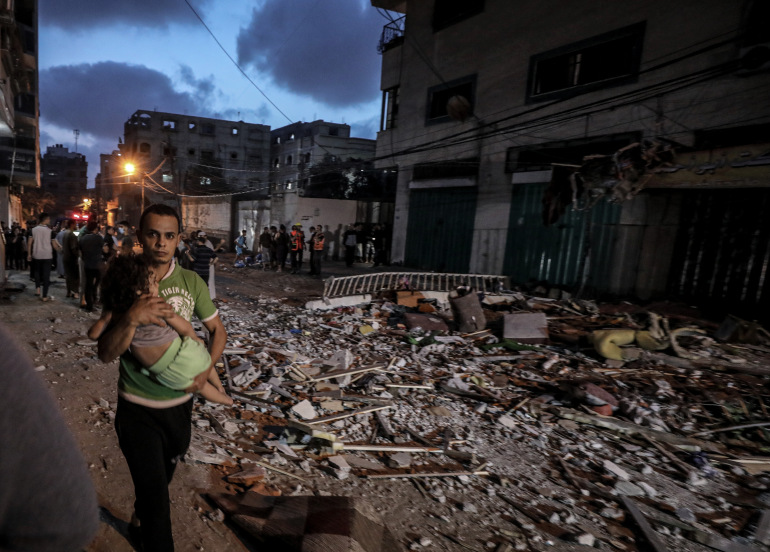Life in the Gaza Strip
Palestinian children are facing the brunt of violence in the region
Photo courtesy of Al Jezeera (Ali Jadallah)
A man holding his child runs away after Israeli warplanes launched airstrikes over Gaza Strip, in May
June 9, 2021
Several weeks ago, rockets streamed out of Gaza and Israel and struck the area with airstrikes, killing dozens. The number of casualties after the attack was 43 Palestinians, including 13 children and three women. Israeli airstrikes have leveled out two multi-story towers in the Gaza Strip, where two million Palestinians lived.
The Gaza fighting began after weeks of rising Israeli-Palestinian tension in East Jerusalem. On May 10, Hamas began firing rockets after warning Israel to withdraw from the site, triggering retaliatory airstrikes. Such exchanges intensified and hostilities escalated into the worst violence between Israel and Gaza since 2014.
The BBC reports before the most recent upsurge in fighting, households in Gaza were receiving power on eight-hour rotations. The latest violence is said to have damaged power lines and upset fuel supplies in Gaza. According to the UN Office for the Coordination of Humanitarian Affairs (OCHA), most homes are now receiving power for only three-four hours per day. Because of the violence in the Strip, 80% of the population in Gaza banks on international aid and consistent with the UN, one million people rely on food aid just to get by.
The blockade imposed by Israel has largely impacted movements in and out of the Strip and the ability to trade. In an attempt to get around the blockade, Hamas has built a network of tunnels that it uses to bring goods into the Strip and also as its underground command center. Israel says the tunnels are also used by militants to move around out of sight and are being targeted by airstrikes.
The UN estimated 140,000 houses were damaged or destroyed in the 2014 violence and it has since aided 90,000 families with rebuilding their homes. OCHA says several hundred homes have been severely damaged in the recent fighting but the full extent of the damage has not been determined yet.
Additionally the BBC reported that “more than 1,000,000 people in Gaza are classed ‘moderately-to-severely food insecure’, according to the UN, despite many receiving some sort of food aid.”
Israeli restrictions on access to agricultural land and fishing have reduced the number of food Gazans can produce themselves and according to Israeli law, there is a fishing limit. Gazans can only fish within a particular distance of the shore. The UN says if the limit were lifted, fishing could provide employment and an inexpensive source of protein for the people of Gaza. After the latest increase in violence, Israel temporarily banned any fishing from the Gaza Strip. Over the years, it has set varying limits on the fishing zone, disrupting the livelihoods of about 5,000 fishermen and related workers. Gazans are not allowed to farm in the Israeli-declared buffer zone, and this has led to a loss in production of an estimated 75,000 tons of produce a year.
In addition to this, most people in Gaza suffer from a shortage of water. Tap water is salty, polluted and not fit for drinking. While most Gazan households are on a piped water network, OCHA says families received water for only six-eight hours every four days in 2017 due to insufficient power. This has been reduced still further by the newest attacks. The World Health Organization set the minimum requirement for daily water needs at 100 liters per head to cover drinking, washing, cooking, and bathing. In Gaza average consumption is about 88 liters.
There are 78% of households connected to public sewage networks, however, treatment plants are still overloaded. OCHA says more than a hundred million liters of partially treated and raw sewage is pumped into the Mediterranean daily. A new wastewater treatment plant came into operation at the start of 2021 to assist affect the matter.
In the opinion of Wikitravel, it describes Gaza as a precious area. “The Gaza strip is an unstable area, effectively a war zone.” Western governments have issued a severe and strict travel warning against entering the Gaza Strip, due to ongoing military conflict. Most consider it effectively a war zone. The Palestinian factions and the Israeli military are well armed and quite willing to shoot when they think it necessary.”
While it is true that the Gaza Strip is arguably one of the worst places to be in the world, the living conditions of Palestinians have to be the priority of Palestinian nationalism. Social media attention and nonprofit organizations are not enough to end the Israeli-Palestinian conflict, an issue that has lasted for a century. It takes more than a story on Instagram to answer a 100-year-old conflict. Tangible action is needed.







